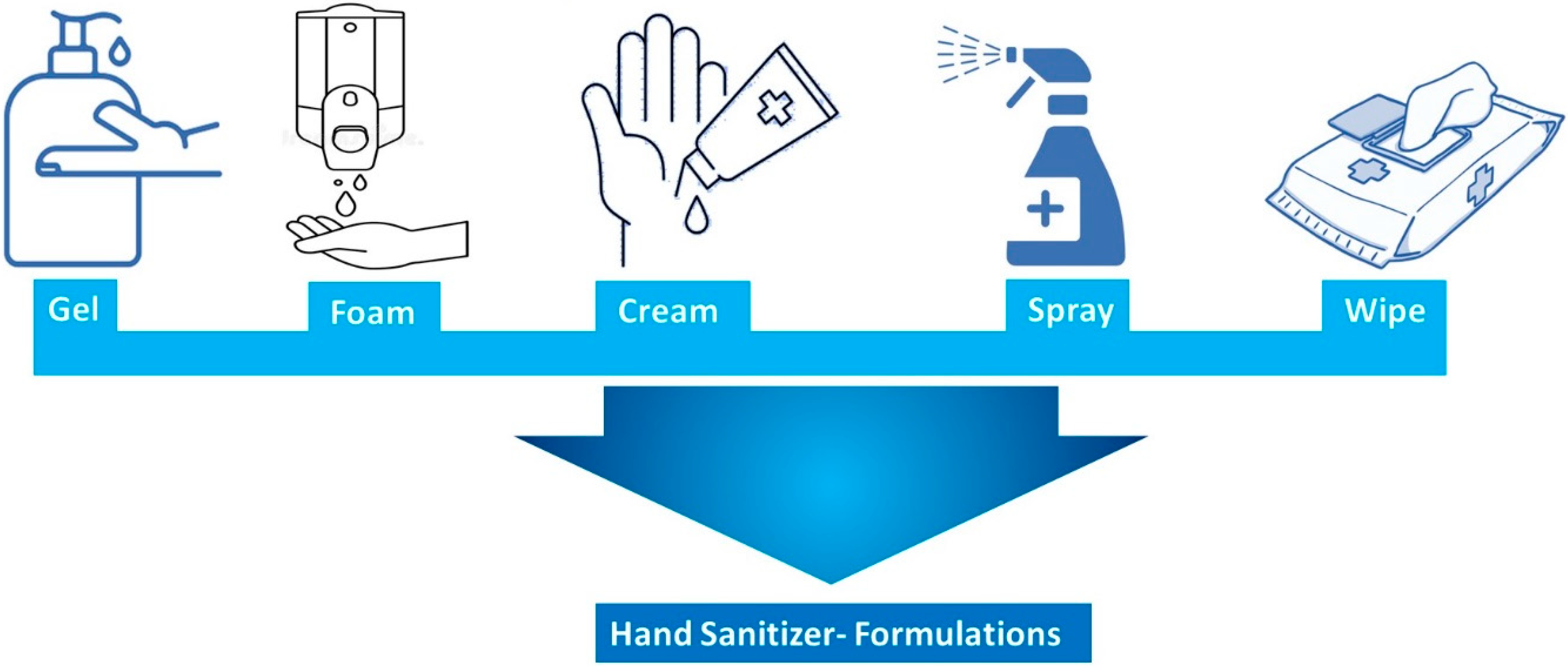Besides Chlorine What Are the Chemical Sanitizers Approved for Operations
Chlorine levels in the water shall not exceed the maximum residual disinfectant limit under the Safe Drinking Water Act. The FDA Food Code identifies a few chemical sanitizers that are approved for use on food-contact surfaces including chlorine iodine and quaternary ammonium.

Ijerph Free Full Text Hand Sanitizers A Review On Formulation Aspects Adverse Effects And Regulations Html
In the food industry the most popular way to sanitize is with chemical sanitizers.

. 2-30116 Hand Sanitizers. Typical preparation is 1 tablespoon of chlorine bleach per gallon of water. Iodine and quaternary ammonium are able to do that in a safe manner which is why they were approved as sanitizers.
Be an approved drug that is listed in the FDA publication Approved Drug Products with Therapeutic Equivalence Evaluations as an approved drug based on safety and effectiveness. 3 Chemical sanitizers shall be equivalent in bactericidal action to a 2-minute exposure of 50 parts per million of available chlorine at 57 degF when used as an immersion or circulating solution. Use this easy comparison chart to see which pool sanitizer is right for you.
When used properly chlorine bleach can be a very effective method of killing undesirable microorganisms. Iodine and quaternary ammonium d. I Calcium hypochlorite ii Chlorine dioxide iii Sodium hypochlorite B.
6 If a chemical sanitizer is generated by a device located on-site at the food establishment the chemical. Read more about Sanitizers here. Chlorine-based sanitizers are the most commonly used sanitizers.
This will provide time for the sanitizer to do its job. This may reintroduce contaminants. Ammonia and isopropyl alcohol b.
Most operations unless the produce is very dirty will not need a sanitizer concentration greater than 200 ppm total chlorine to achieve the desired sanitizing effect. This guidance document will walk you through the safe and effective use of chlorine as a disinfectant. The amount needed is very small and no chlorine residue will be left behind using a concentration of 1 scant teaspoon of chlorine bleach to 1 quart of water.
Never wipe dry a surface. To get the most out of your sanitizers keep three factors in mind. The concentration of chlorine ASC and PAA was selected based on previous studies 101819.
Detergents and dirt inactivate chlorine. Hydrogen peroxide and quaternary ammonium c. Comply with one of the following.
Dilute mixtures of chlorine bleach and water are a common and cost-effective method for sanitizing equipment in food processing operations. Acid varies with the pH of the solution. These are chemicals which help to remove pathogens from the surface of materials.
The regulations do not specify a permissible residual level of. Approved no-rinse food contact sanitizers and non-product contact sanitizers and their formulations and usage levels are listed in the Code of Federal Regulations 21 CFR 1781010. The most common pool sanitizer is chlorine but the best pool sanitizer depends on factors like your budget type of pool indoor or outdoor and maintenance routine.
In 1999 the National Sanitation Foundation started to maintain the White Book - Nonfood Compounds Listing Directory. Or 5 If a chemical sanitizer other than chlorine iodine or a quaternary ammonium compound is used it shall be applied in accordance with the EPA-registered label use instructions. How do the names of molecular compounds differ from the names of ionic compounds.
Chlorine reacts quickly and becomes inactive quickly. Chlorine as a Sanitizer. Temperature concentration and time.
Besides chlorine what are the chemical sanitizers approved for operations. Diluted chlorine bleach is a very effective sanitizer. The efficacy of sanitizers were tested at various temperatures that were relevant to processing plants in Australia.
Hydrogen peroxide also called hydrogen dioxide can be used as a sanitizer of fruits and vegetables as a liquid or gas. Processors should be aware however that there are regulations concerning the use of this sanitizer. Hypochlorous acid becomes ineffective above pH 85 but chlorine dioxide retains some sanitizing power up to pH 100.
Original NOSB Recommendation In November 1995 the NOSB approved the following recommendation concerning the use of chlorine. Chemical sanitizers applied as a spray or fog shall have as a minimum 100 parts per million of available chlorine at 57 degF or its equivalent in. The following active ingredients are allowed in sanitizers used on organic food contact surfaces and equipment with a noted restriction on chlorine sanitizers.
A hand sanitizer and a chemical hand sanitizing solution used as a hand dip shall. Yes the same hydrogen peroxide having a variety of uses including eyewash mouthwash nasal spray depending on the concentration used. Contact times of one minute or greater are typically sufficient to achieve a thorough kill.
Improper use of chlorine could lead to incomplete sanitization or contamination of produce with excess chlorine. Besides chlorine what are the chemical sanitizers approved for operations. The four sanitizers were chlorine acidified sodium chlorite ASC PoultrypHresh and peroxyacetic acid PAA.
Chlorine Materials see notes below Hydrogen peroxide Ozone Peracetic acidperoxyacetic acid Phosphoric acid Potassium hydroxide Sodium hydroxide. Chlorine is both an inexpensive and effective disinfectant if it is used properly. After the sanitizing solution is applied allow the surface to air dry.
The concentration of PoultrypHresh was used. Isopropyl alcohol and hydrogen peroxide. A neutralization reaction is a reaction between choose.
Iodine and quaternary ammonium are chemical sanitizers approved for operations. What is a Sanitizer. Chlorine dioxide is a stronger oxidizer than other chlorine sanitizers and it is less likely to form chlorinated organic compounds.
Surfaces must be cleaned first. 50- to 100 ppm with a test strip. When using quaternary ammonia or other chemical sanitizers it is.
There are two commonly used chemical sanitizers used in food establishments either for preparing a three-compartment sink or a sanitizer bucket.

Chlorate Is An Emerging Residue Of Concern Within The Dairy F B Industries

Disinfecting Agents For Controlling Fruits And Vegetable Diseases After Harvest Sciencedirect

Food Grade Sanitizer What Are Approved Sanitizers For Food Service
Comments
Post a Comment